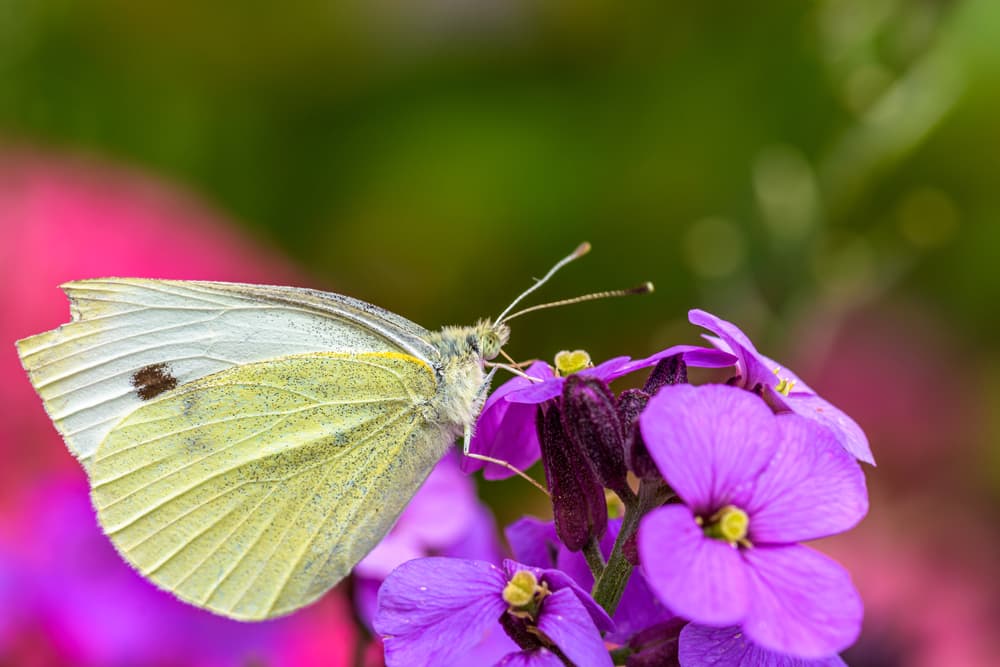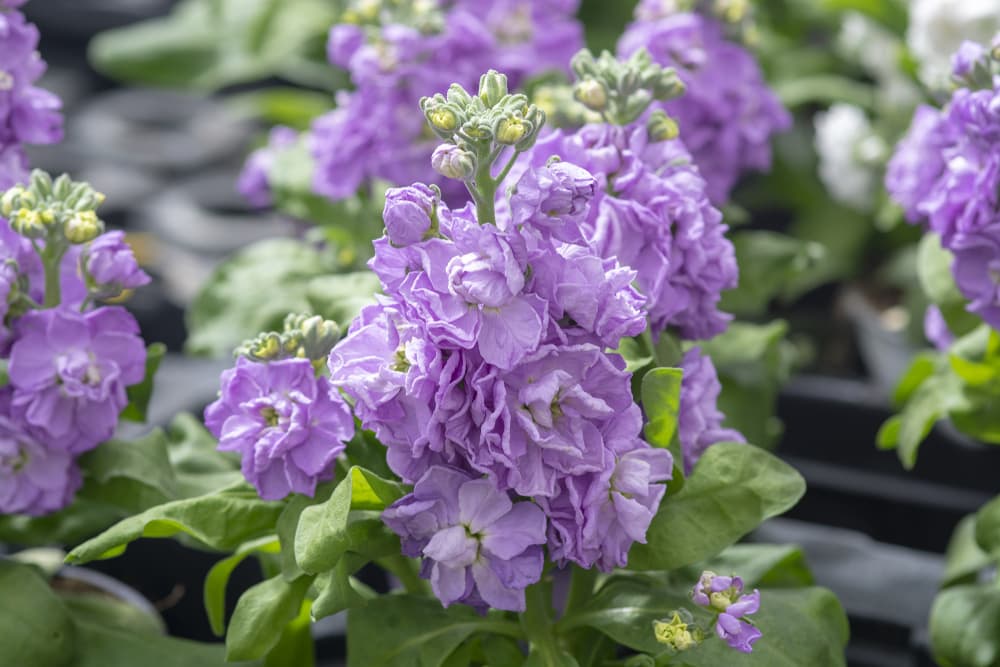PERENNIALS > ERYSIMUM
Reviewed By COLIN SKELLY

Colin is a Horticulturist and Horticultural Consultant with experience in a range of practical and managerial roles across heritage, commercial and public horticulture. He holds the Royal Horticultural Society’s Master of Horticulture award and has a particular interest in horticultural ecology and naturalistic planting for habitat and climate resilience.
IN THIS GUIDE
ERYSIMUM GUIDES
Erysimum is one of the most underrated of all flowering plants.
Commonly known as the ‘Wallflower,’ this delightful plant has everything going for it.
It is fairly disease-free, is low-maintenance, and is as at home by itself in a pot on a patio as it is with a motley crowd in a large bed.
As for those vibrant blooms, they’re no ‘wallflowers’; they’re dazzling knockouts!
Erysimum is quite a varied genus comprising of annual, biennial, and perennial plants.
As herbs and sub-shrubs, they are dainty little things individually but make for a lush carpet collectively.

They make excellent bedding choices but are also genuinely ornamental flowering plants in their own right.
Many species flower abundantly from early spring to late summer, and some even dazzle with autumn blossoms.
The small four-petalled flowers usually occur as racemes – their colours include white, cream, yellow, orange, red, and purple, many of which are of a vibrant hue.
Besides being colourful, the blooms are also sweet-scented and are attractive to bees, butterflies, and other pollinators.

Their foliage too is pleasing to the eye, being in the main of a chalky green colour with a bluish tinge.
The daintiness of the stiff, narrow, lance-shaped leaves makes for a fine match to the flowers, and complement them wonderfully well.
Erysimum sub-shrubs are sometimes grown as upright plants by themselves while herbaceous Erysimum varieties – besides the sub-shrubs – are grown in beds, and often occur in their native habitats in clumps and gently swaying mounds.
Overview
| Botanical Name | Erysimum |
| Common Name(s) | Wallflowers |
| Plant Type | Perennial / Annual / Biennial Flower |
| Native Area | South Asia, Europe, Africa, Micronesia, North America – through Costa Rica |
| Hardiness Rating | H4 |
| Foliage | Evergreen |
| Flowers | Fragrant four-petalled flowers |
| When To Sow | February, March |
| Flowering Months | March, April, May, June, July, August, September, October, November |
Sunlight
Preferred
Full Sun
Exposure
Exposed or Sheltered
Size
Height
0.5 – 1M
Spread
0.5 – 1M
Bloom Time
March – November
Soil
Preferred
Chalk, loam, sand
Moisture
Well drained
pH
Alkaline / Neutral
Wallflowers are members of the mustard family, Brassicaceae.1The genus Erysimum (Brassicaceae) in Bulgaria. (n.d.). JSTOR. Retrieved March 15, 2023, from https://www.jstor.org/stable/41767349
Similar to mustard and rapeseed plants, they manufacture phytochemicals that repel insects which would otherwise feed upon the flowers.2Züst, T., Strickler, S. R., Powell, A., Mabry, M. E., An, H., Mirzaei, M., York, T. M., Holland, C. K., Kumar, P., Erb, M., Petschenka, G., Gómez, J. M., Perfectti, F., Müller, C., Pires, J. C., Mueller, L. A., & Jander, G. (2020). Independent evolution of ancestral and novel defenses in a genus of toxic plants (Erysimum, Brassicaceae). ELife, 9. https://doi.org/10.7554/elife.51712
The Wallflower has a pleasant (or unpleasant, depending on your point of view) proclivity to take root in the interstices of bricks and stones of a wall, hence its colloquial and common name, ‘Wallflower’.
In a very literal sense this flower grows from and on walls.

It is a not-uncommon site on the stone ramparts of old castles and brick walls in the British Isles.
Habitat & Growing Conditions
Erysimum species occur very widely nearly throughout Europe, Asia, and North America.
Their range is so extensive that it would be easier to mention the regions to which they are not native or introduced.
Most species are best suited to soils that are dry and very well drained with pH ranging from neutral to mildly alkaline.

Most prefer full sun but can make do in partial shade.
Hardiness
In the main their hardiness falls between RHS Zones H4 – H6.
However, a few species native to Northern climes are hardy to H6 – H7.
Erysimum is either annual (flowering in summer for one season), biennial (planted in autumn and flowering the following spring) or perennial (lasting for several years).
How To Grow Wallflowers
Depending on the particular species or cultivar, Wallflowers can be grown virtually year-round but mid-Spring and late-Autumn are the best times to grow from seed.
Planting
In the United Kingdom, Erysimum should be planted where it can get full sun or sun with partial shade.
In general it is best placed in loose chalky and sandy soils that are not overly rich nor moist – soil must have very good drainage.

You can’t go wrong with slightly alkaline soil.
In general, a good mix of different Erysimum species will provide a fantastic splash of brilliant colour in spring and summer.
Wallflowers are among the best put-anywhere plants.
Choose from the varieties listed above for beds, borders, and even accents in rock gardens.

They are perfect for flower pots on parapets and hanging baskets on balconies.
Many varieties self-seed, so once grown, you can just let these plants renew themselves in your garden.
“One of the best wallflowers for the garden is E. ‘Bowles’s Mauve’, a perennial cultivar that will flower for most of the year,” shares Master Horticulturist Colin Skelly.
“I use this plant a lot in planting designs both for its quick establishment and its value as a flower for pollinators, particularly early in the year.”
Erysimum Care
One of the many great attributes of Erysimum is that it is a low-maintenance plant that makes do with what little it gets.
Though this does not mean that it should be neglected, this happy plant is ideally suited for busy lifestyles that leave little time for gardening.
Erysimum plants really do not need fertiliser – within the Plant World these diminutive things are real troopers!

A small amount of slow-release 10-10-10 fertiliser can certainly be given to them as a special treat.
It should be kept in mind that what is written in this section and the following ones does not and cannot apply to Erysimum as a genus – it has over 200 species that are native to very different geographic locations.
The advice and recommendations given here apply only to the species, hybrids and cultivars commonly found or grown in the United Kingdom.
Common Problems
The most common problem Wallflowers face are slugs and snails.
Slugs are nocturnal so you may have a slug problem without being aware that the damage being caused to your plants is from slugs.
A variety of slug-control methods have been devised, from beer traps and diatomaceous earth to microscopic nematodes.
The other main worry is downy mildew, which is tough to combat.
Promptly remove all affected parts and ensure that the plant is not crowded in by other plants and has plenty of sun and air.
References
- 1The genus Erysimum (Brassicaceae) in Bulgaria. (n.d.). JSTOR. Retrieved March 15, 2023, from https://www.jstor.org/stable/41767349
- 2Züst, T., Strickler, S. R., Powell, A., Mabry, M. E., An, H., Mirzaei, M., York, T. M., Holland, C. K., Kumar, P., Erb, M., Petschenka, G., Gómez, J. M., Perfectti, F., Müller, C., Pires, J. C., Mueller, L. A., & Jander, G. (2020). Independent evolution of ancestral and novel defenses in a genus of toxic plants (Erysimum, Brassicaceae). ELife, 9. https://doi.org/10.7554/elife.51712


